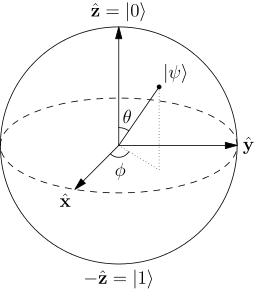Topological quantum computer
A topological quantum computer is a theoretical quantum computer that employs two-dimensional quasiparticles called anyons, whose world lines cross over one another to form braids in a three-dimensional spacetime (i.e., one temporal plus two spatial dimensions). These braids form the logic gates that make up the computer. The advantage of a quantum computer based on quantum braids over using trapped quantum particles is that the former is much more stable. The smallest perturbations can cause a quantum particle to decohere and introduce errors in the computation, but such small perturbations do not change the braids' topological properties. This is like the effort required to cut a string and reattach the ends to form a different braid, as opposed to a ball (representing an ordinary quantum particle in four-dimensional spacetime) bumping into a wall. Alexei Kitaev proposed topological quantum computation in 1997. While the elements of a topological quantum computer originate in a purely mathematical realm, experiments in fractional quantum Hall systems indicate these elements may be created in the real world using semiconductors made of gallium arsenide at a temperature of near absolute zero and subjected to strong magnetic fields.
Introduction
Anyons are quasiparticles in a two-dimensional space. Anyons are not strictly fermions or bosons, but do share the characteristic of fermions in that they cannot occupy the same state. Thus, the world lines of two anyons cannot cross or merge. This allows braids to be made that make up a particular circuit. In the real world, anyons form from the excitations in an electron gas in a very strong magnetic field, and carry fractional units of magnetic flux in a particle-like manner. This phenomenon is called the fractional quantum Hall effect. The electron "gas" is sandwiched between two flat plates of aluminium gallium arsenide, which create the two-dimensional space required for anyons, and is cooled and subjected to intense transverse magnetic fields.
When anyons are braided, the transformation of the quantum state of the system depends only on the topological class of the anyons' trajectories (which are classified according to the braid group). Therefore, the quantum information which is stored in the state of the system is impervious to small errors in the trajectories. In 2005, Sankar Das Sarma, Michael Freedman, and Chetan Nayak proposed a quantum Hall device which would realize a topological qubit. In a key development for topological quantum computers, in 2005 Vladimir J. Goldman, Fernando E. Camino, and Wei Zhou were said to have created the first experimental evidence for using fractional quantum Hall effect to create actual anyons, although others have suggested their results could be the product of phenomena not involving anyons. It should also be noted that non-abelian anyons, a species required for topological quantum computers, have yet to be experimentally confirmed.
Topological vs. standard quantum computer
Topological quantum computers are equivalent in computational power to other standard models of quantum computation, in particular to the quantum circuit model and to the quantum Turing machine model. That is, any of these models can efficiently simulate any of the others. Nonetheless, certain algorithms may be a more natural fit to the topological quantum computer model. For example, algorithms for evaluating the Jones polynomial were first developed in the topological model, and only later converted and extended in the standard quantum circuit model.
Computations
To live up to its name, a topological quantum computer must provide the unique computation properties promised by a conventional quantum computer design, which uses trapped quantum particles. Fortunately in 2002, Michael H. Freedman along with Zhenghan Wang, both with Microsoft, and Michael Larsen of Indiana University proved that a topological quantum computer can, in principle, perform any computation that a conventional quantum computer can do.
They found that a conventional quantum computer device, given an error-free operation of its logic circuits, will give a solution with an absolute level of accuracy, whereas a topological quantum computing device with flawless operation will give the solution with only a finite level of accuracy. However, any level of precision for the answer can be obtained by adding more braid twists (logic circuits) to the topological quantum computer, in a simple linear relationship. In other words, a reasonable increase in elements (braid twists) can achieve a high degree of accuracy in the answer. Actual computation [gates] are done by the edge states of a fractional quantum Hall effect. This makes models of one-dimensional anyons important. In one space dimension, anyons are defined algebraically.
Error correction and control
Even though quantum braids are inherently more stable than trapped quantum particles, there is still a need to control for error inducing thermal fluctuations, which produce random stray pairs of anyons which interfere with adjoining braids. Controlling these errors is simply a matter of separating the anyons to a distance where the rate of interfering strays drops to near zero. Simulating the dynamics of a topological quantum computer may be a promising method of implementing fault-tolerant quantum computation even with a standard quantum information processing scheme. Raussendorf, Harrington, and Goyal have studied one model, with promising simulation results.
See also
References
- Collins, Graham P. (April 2006). "Computing with Quantum Knots". Scientific American.
- Sarma, Sankar Das; Freedman, Michael; Nayak, Chetan (2005). "Topologically Protected Qubits from a Possible Non-Abelian Fractional Quantum Hall State". Physical Review Letters (94): 166802. doi:10.1103/PhysRevLett.94.166802.
- Nayak, Chetan; Simon, Steven H.; Stern, Ady; Freedman, Michael; Sarma, Sankar Das. "Non-Abelian Anyons and Topological Quantum Computation". Review of Modern Physics (80): 1083 year=2008. doi:10.1103/RevModPhys.80.1083.
- Raussendorf, Robert; Harrington, Jim; Goyal, Kovid (2007). "Topological fault-tolerance in cluster state quantum computation". doi:10.1088/1367-2630/9/6/199.
- Simon, Steven H.. "Quantum Computing with a Twist".
| ||||||||||||||||||||||||||||||||||||||||||||||
